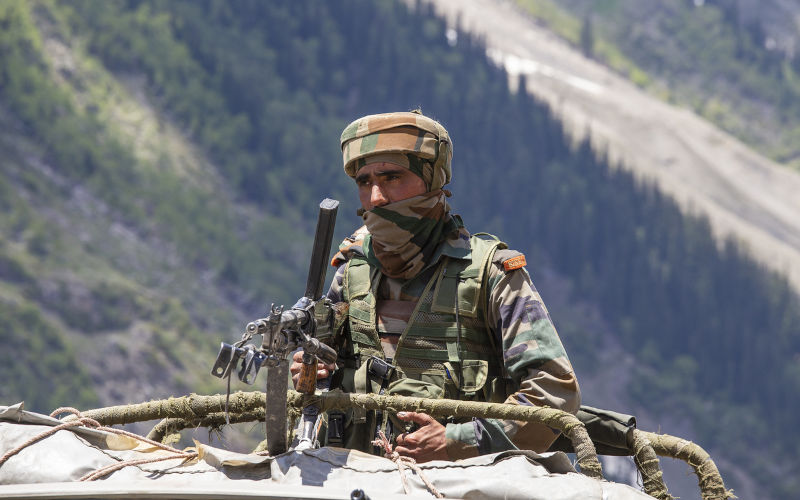The Kashmir insurgency
April 2, 2023
One of the world’s oldest unresolved international issues, _Kashmir__, has experienced many stark vicissitudes over time. In 2019, it made headlines due to India’s controversial revocation of Article 35A and 370, which essentially eliminated Kashmir’s special status and autonomy._
This led to overarching vehemence amongst Kashmiris who protested in droves. To subdue them, thousands of Indian troops were stationed and an inhumane one-and-a-half-year-long lockdown was imposed. In the chaos, thousands of Kashmiris were arrested while around 70 people died.
These sights evoked memories of the brutal insurgency that wrapped the Kashmir valley from 1988 to 2004. Often overlooked, a brief history of this insurgency is integral in showcasing how Kashmir, India, and Pakistan are interlaced in this conflict.
Following the India-Pakistan war over Kashmir in 1947, UNSC resolution 47 was passed (21 April 1948). The resolution asserted that the Kashmir question is resolved via a free and fair plebiscite. The Indian government promised to do so, but this has never transpired.
From 1948 onwards, instead of addressing the “plebiscite” question, Delhi chose to co-opt Kashmiri politicians to discourage the Kashmiri freedom movement. However, rigged elections, the influence of Delhi-controlled prime ministers, and nepotism over the decades since 1947 meant that Kashmir was only a mock democracy. Despite Indian attempts to suppress Kashmiris’ desires for an independent homeland, the situation deteriorated over time, culminating in a point of no return.
The final straw came with the 1987 legislative elections, which were widely regarded as a sham. The Congress-supported Farooq Abdullah, son of Sheikh Abdullah, became chief minister and formed a coalition government, but his administration lacked legitimacy among Kashmiris – this led the Kashmiri freedom movement to cross the threshold into militancy.
In 1998, several strikes, demonstrations, and attacks on the Indian government signalled the beginning of the insurgency. Delhi’s massive electoral rigging coupled with an opportunistic Pakistan’s support fuelled the fire of insurgency. By 1991, gunfire and explosions had become commonplace in the Kashmir Valley, with young men carrying AK47s roaming the streets of Srinagar and other major towns. This became the most serious security problem in India in the 1990s.
In the nascent phase of the insurgency, the Jammu Kashmir Liberation Front (JKLF), a militant group, led by Yasin Malik gained prominence, demanding an independent and secular Kashmir separate from both India and Pakistan. Bandhs (strikes) and Hartals (closure of shops) became routine, accompanied by JKLF-sponsored bombings, attacks on government buildings, and assassinations. Delhi responded severely, and at times used indiscriminate means to combat the insurgency, resulting in the deaths of hundreds of insurgents and innocent civilians.
Draconian laws such as The Armed Forces Special Powers Act (AFSPA) were extended to Jammu and Kashmir (J&K) in 1990, granting soldiers a free pass to shoot to kill, arrest, and search without a warrant in designated “disturbed” areas. This act also provides security forces personnel with impunity from civil prosecution, which has been condemned by Amnesty International, and other groups who have been calling for its repeal. Notable human rights violations committed by Indian forces during this period include the Gawkadal massacre where 50-300 Kashmiris were killed. Furthermore, the Sopore and Bijbehara massacres saw 57 and 51 Kashmiri civilians killed respectively.
Human rights abuses were also committed by Kashmiri insurgents. For example, the Kashmiri Pandits, who were the native Hindus of the region, were targeted by militant groups including the JKLF. As a result of the violence and persecution, many Pandits were forced to leave the valley in the 1990s, with estimates suggesting that around 100,000 out of 140,000 left.
In time, the JKLF lost ground due to the Indian counterinsurgency efforts and was replaced by the pro-Pakistan Hizbul Mujahideen (HM) in the movement. Pakistan favoured a group that supported its agenda of making Kashmir a part of Pakistan, rather than the JKLF’s demand for independence. Therefore, in 1991, Pakistan directed its patronage towards the HM while also working to cause defections and splits within the JKLF. The HM consisted mainly of Kashmiris who received training and weapons from Pakistan-administered Kashmir by crossing the LoC (Line of Control). Additionally, after the Soviet-Afghan War, many non-Kashmiri militants joined the insurgency, which eventually led to the hijacking of the movement. As a result, the insurgency took on a different character due to the influence of the Pakistani government and the Islamist ideology of the Afghan mujahedeen who defeated the Soviets.
These factors eventually had a detrimental effect on the movement, with many Kashmiris seeing this version as foreign and discerning the rapid influx of violence as unfavourable. These factors, combined with India’s counterinsurgency efforts, although often indiscriminate, led to a decline in the movement. In the mid-1990s, many insurgents either surrendered their weapons or chose to collaborate with Indian security agencies. The JKLF pledged to continue its struggle peacefully while the HM lost its enthusiasm in the mid-1990s due to a war of attrition with Indian security forces.
Following this loss in intensity, the region experienced around 50 fidayeen attacks from mid-1999 until end of 2002, which were carried out by insurgent groups that targeted both security forces and civilians. The militant group Lashkar-e-Taiba (LeT) rose in prominence with the support of Pakistan and was involved in many such attacks.
Following the 9/11 attacks, however, things changed immensely. The US pressured Pakistan to retract its support to proxy groups and join the War on Terror. Siding with the US, however, led to an insurgency on Pakistani soil as anti-American militant groups became hostile towards the country. This further slashed the militancy aspect of the Kashmiri struggle as Pakistan’s support was no longer forthcoming.
This did not, however, mean that ordinary Kashmiri people and India had reconciled. On the contrary, Kashmir’s desire for freedom remained high but militancy dwindled. Today, the stone-pelting Kashmiri youth and protests characterise the struggle.
Trapped between two nuclear powers, who have fought 3 wars over it and might fight another soon, Kashmiris remain hopeful for a solution to their existential dilemma.
